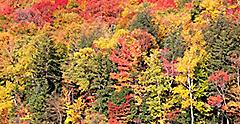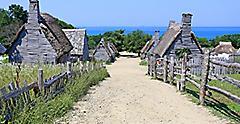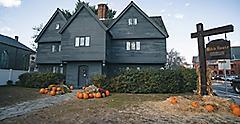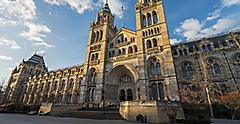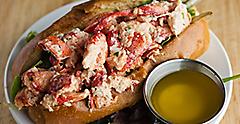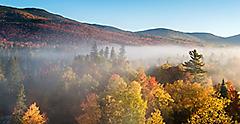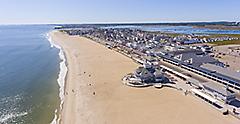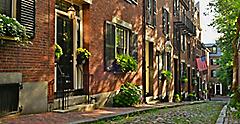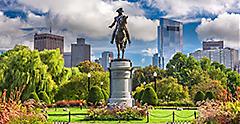By Eben Diskin | Published on January 11, 2024
Wander Through The Colonial Past
Visiting the Northeast means getting acquainted with its history, which still defines the region to this day. Long before Europeans arrived, between 70,000 and 100,000 Native Americans lived in New England at the start of the 17th century, subsisting on fishing, hunting, gathering and trade with European merchants. The Pilgrims' arrival in Massachusetts in 1620 marked the beginning of a disruption to Native Americans' way of life and their gradual displacement and marginalization. Several landmarks in the Northeast region commemorate the area's Native American past. These are must-visits for anyone looking to immerse themselves in the Northeast's history.
Dive Into Lobster Rolls, Clam Chowder And More
It's hard to get a sense for any destination without sampling its food. One of the most interesting facts about the Northeast region and its cuisine is that it includes far more than seafood. There are also a wide range of regional dishes — apart from the classic seafood staples — steeped in cultural tradition and quirky history.
Of course, any visitor to the Northeast will want to try the fresh seafood. From clam shacks lining the seaboard to classic fish and chip joints and more upscale lobster restaurants, you won't get tired of the Northeast's seafood anytime soon. Start off with a Maine lobster roll — a staple of the region. Prepared traditionally, you can look forward to chopped lobster on a split-top hot dog bun with mayo. And then, of course, there's clam chowder. You can probably find it anywhere in the country, but no place else makes it like the Northeast. New England clam chowder consists of clams, diced potatoes and onions in a milk-based broth. Manhattan clam chowder is another option, which has a tomato base.
Hike The Ancient Forests And Snow-Capped Mountains
New England is known for its historic architecture, but to some, one of the most surprising Northeastern facts is that the region's natural beauty is among the best in the country. Whether it's the forests of Maine dotted with lakes, the beaches of Cape Cod or the lighthouse-lined coast spanning hundreds of miles, New England lives up to its postcard reputation. The best way to experience the region's natural wonders is by diving into the rugged wilderness.
Mount Washington is one of the best hikes in the Northeast. As the region's tallest mountain, it stands at 6,288 feet and offers some of the most impressive views anywhere in the country. If you're not quite in the mood for a strenuous hike, you can also drive up the mountain for a shortcut to the views — and then slap on a bumper sticker that says, "This Car Climbed Mt. Washington."
Indeed, there's a reason people from all over the Northeast head to New Hampshire for outdoor adventure. Home to the White Mountains, the state boasts some of the most dramatic scenery in the region, particularly in Franconia Notch State Park. This mountain pass, between the White Mountains and the Kinsman Range, is known for its lakes, snow-capped peaks, gorges and now "deceased" Old Man of the Mountain rock formation. The Artist Bluff Trail is one of the best ways to explore the park. It's an easy 1.5-mile loop that takes you through the mountains with stunning panoramas the whole way.
Where To Spend A Northeastern Vacation
With so much to do in the Northeast, where do you even start? Unfortunately, it's impossible to see every city, climb every mountain or consume every type of fish in just one visit. First, figure out what kind of trip you want to have. Are you looking for a beach vacation? A history tour? An outdoor adventure? One of the most important Northeastern facts is this: There's something for everyone. You just have to plan accordingly.
For a beach weekend, Cape Cod is one of the best vacation spots in the Northeast. The Massachusetts peninsula is immensely popular with local residents, many of whom flock to the Cape on summer weekends. From the nightlife of Hyannis and Provincetown to the more relaxing beaches of Dennis and Eastham, Cape Cod feels like its own world, where the troubles of everyday life wash away in a salty undertow.
If immersing yourself in U.S. history is your goal, head to Boston. In addition to the city's natural historic aesthetic — with cobblestone streets, centuries-old churches and Revolution-era taverns — there's the famous Freedom Trail. Follow the route to see a collection of museums, meeting houses and cemeteries all telling the story of the American Revolution. Sites include the Old South Meeting House, Old State House, Boston Massacre Site, Faneuil Hall, Paul Revere House, Bunker Hill Monument, USS Constitution and Granary Burying Ground.
Nature lovers should pack up the car, hit the road and plunge into the lush wilderness of Maine. Bar Harbor is the best of all worlds — it's right on the ocean, with all the beach benefits you've come to expect from the region, while also providing access to some incredible hiking trails through the forest. The Bar Island Trail, Dorr Mountain North Ridge Trail and Cadillac Mountain North Ridge Trail are perfect for drinking in the area's natural beauty. And when you're done, stop back in the quaint town for some ice cream and lobster rolls.
Get Royal Deals, Sign Up Today

Getting There
Explore Our Most Affordable Itineraries
To put these Northeastern facts to good use and see all the region has to offer, check out one of Royal Caribbean's Northeast cruises.
Related Articles

Family Cruise Activities on Ovation of the Seas
READ MORE

Cruises are the Best Birthday Weekend Getaways | Royal Caribbean Cruises
READ MORE

10 Galveston Camping Tips | Royal Caribbean Cruises
READ MORE
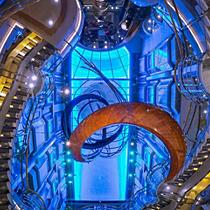
Free Things To Do Onboard Explorer of the Seas
READ MORE

